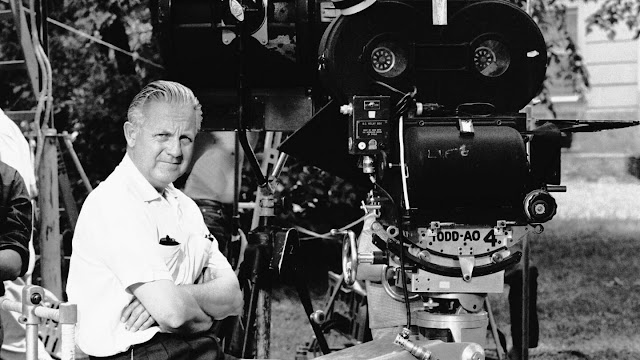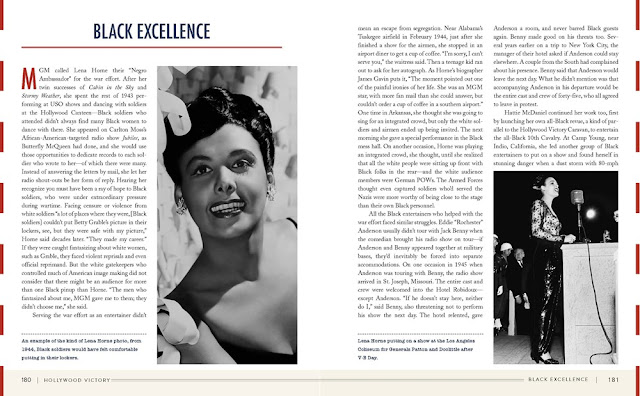Raquel Stecher: Congratulations on the publication of The Essential Directors! How did you come to write this book?
Sloan De Forest: Thank you! I had already written two books for Turner Classic Movies and Running Press (
Must-See Sci-Fi and
Dynamic Dames), so I had a foot in the door to do another. I always wanted to tackle the subject of classic film directors, and I got lucky because TCM had always wanted to do a directors guide. It was offered to me and I seized the opportunity.
Raquel: Your book covers so much in scope that I felt like each chapter was a class on a director. What went into the research for this project?
Sloan: Even though each director profile is really just a brief overview of career highlights, every one required a deep dive into the director and their work. After all, I had to be familiar with someone’s entire career in order to know which films and facts to focus on and which ones to gloss over, if nothing else. So the research process was massive. I immersed myself in books, newspaper/magazine archives, and movies, movies, movies. Even films I had already seen several times before I re-examined closely, along with poring over interviews and quotes from the filmmakers. It was fun, but due to the pandemic, I had a hard time getting my hands on the materials, so it was stressful at times.
Raquel: What was the decision making process like to figure out which directors to include?
Sloan: It was an epic poem. First I made a long list of about 100 noteworthy directors and then with TCM’s help I whittled it down, based on who made the most significant contributions to the industry and art form. There was simply not room to include everyone or the book would have been too big to lift! In fact, we had to cut six filmmakers (or move them to sidebars) after I had already written whole sections on them. In an effort to be inclusive and thorough, I initially overwrote the book, cramming it too full. So that was a challenge, plus there is always some subjectivity involved. Ultimately how do we judge the most “essential directors?” It’s a tough one, and everyone won’t agree. That’s okay. I love how the book turned out: a compendium of pioneers who created some of the most memorable movies in classic Hollywood. It’s supposed to be curated, not encyclopedic, yet I was able to mention hundreds of directors, even if only to give them a nod.
 |
| Frank Capra |
 |
| Lois Weber |
 |
| Robert Wise |
Raquel: Out of the directors selected, who do you think is the most underrated of the bunch?
Sloan: In the book, I write that Robert Wise may be the most underrated director of the classic era, and it’s probably true. He was not a director of the bombastic, egomaniacal variety, and so I think his artistry has long been minimized. George Cukor is another who isn’t given his full due because these men were not auteurs; they didn’t make personal films. But they made some of the greatest movies ever, so surely they were doing something right! Lois Weber is sadly forgotten today, and Frank Capra is a personal favorite whose films are often unjustly dismissed as too sentimental. But he was brilliant, in my opinion.
Raquel: I love that you included female directors like Lois Weber, Dorothy Arzner and Ida Lupino. How have women played a role in filmmaking during the early years before it became a male dominated field?
Sloan: In the early days of motion pictures, women directors were more common than today, over a century later—which is sheer madness, when you think about it. Also, about 50% of the screenwriters were women in the silent days, and of course half the major stars were women through the 1940s. So ladies made vast contributions to the medium in its first few decades. Hollywood only started to become a boys’ club when sound took over, and this is when many female directors like Lois Weber found themselves out of a job.
Raquel: If you were to write a second volume, which directors do you think you'd like to cover?
Sloan: Speaking of women directors, I would love to write in more detail about Frances Marion, who was so discouraged by her work being judged “feminine” that she only directed two films, and then gave up and stuck to screenwriting. Also Marguerite Duras had an interesting career. In a second volume, I could also tackle the filmmakers of the 80s, 90s and 2000s like Spike Lee, Quentin Tarantino, Guillermo del Toro, and so many others that rose to prominence after the chronology of the book, which ends in the 70s. As for classic-era directors I couldn’t fit in volume one, Busby Berkeley, Charles Vidor, William Wellman, William Friedkin, Don Siegel, Satyajit Ray, and Sam Peckinpah are a few that spring to mind, but there are dozens.
Raquel: Why is it important for movie lovers to understand not only the history behind these film directors but also the era they worked in?
Sloan: That’s a great question. Understanding the backdrop of the time period is essential to form a complete picture of why these directors and their films matter at all, which is why I like to include quotes from original reviews from the time these films were released. If someone doesn’t know that Stanley Kubrick was the first to realistically depict outer space and spacecraft in 2001, they may think “what’s the big deal?” because we’ve all seen realistic outer space depictions so many times since 1968 that we take them for granted. If someone doesn’t know that interracial romances were strictly forbidden under the Production Code from the early 1930s through the early 1960s, they might ask why these directors cast Caucasian actors in non-Caucasian roles. I could go on, but you get the point. Historical context is crucial to appreciate classic films and the artists behind them.
Raquel: I loved how in each section you boiled down a filmmaker's career into one beautiful line. For example for Douglas Sirk it was
“he had earned the moniker Master of Melodrama for his aesthetically lush tearjerkers that immersed Eisenhower-era audiences in a world of gilt-edged passion, enriched by his signature use of oversaturated Technicolor.”
Can you tell us a bit about how you approached capturing the essence of each director?
Sloan: In addition to “zooming in” on some specifics, I did feel it was important to “zoom out” and try to encapsulate a filmmaker’s style or career in one or two sentences, so I’m happy you feel I succeeded. That was a big deal because I didn’t want to sell any director short or misinterpret his or her place in film history. Perhaps that’s why I put some extra effort into those sentences. With everyone I covered, I would remind myself “This is someone’s all-time favorite director” even if it wasn’t mine. Then I would ask myself, “What’s so special about this person? What did they do like no one else?” Then I would find the best words I could to define it.
Raquel: Controversy is no stranger to Hollywood’s history with directors and some names including D.W. Griffith, Roman Polanski and Woody Allen now have tarnished reputations. How did you tackle including these controversial figures in your book?
Sloan: Frankly, that was the most trying aspect of the process. Some particularly unsavory scandals have come to light about these directors in recent years, and I couldn’t ignore that. Yet I also could not bring myself to omit certain directors from the book based on their actions as people, no matter how reprehensible—especially Roman Polanski, who is behind two of my all-time favorite movies, Rosemary’s Baby and Chinatown. So the way I handled it was to discuss the good and the bad elements honestly. I think that’s any historian’s job, to present the facts as they were and not spin them into judgment or opinion, even though it’s tempting. History is history, and it’s not always nice or easy. In my opinion, every facet of film history is fascinating, the dark and the light.
Raquel: This is your third book with TCM and Running Press and you've contributed to others. What's it been like working with them?
Sloan: Both have been wonderful to work with. Everyone at Running Press gave me creative freedom and stood by my decisions on which directors to include—even the problematic ones—and TCM has had my back the whole way, facilitating two fabulous forewords (from Peter Bogdanovich and Jacqueline Stewart) and even inviting me on air to discuss the book with Alicia Malone, who was great. Believe me, I am not obligated to say this, but from the heart: thank god for Turner Classic Movies. Where would we be today if Ted Turner hadn’t seen the value in old films and devoted an entire network to screening them uncut? I doubt there would be nearly as much awareness of the classics, nor budgets for preserving and restoring them. Thanks, Ted!
Raquel: What do you hope readers take away from reading The Essential Directors?
Sloan: As the title suggests, my main goal was to spotlight the profound impact and influence these directors have had. Those of us who watch a lot of older movies see the origins of so many ideas and techniques that are commonplace today, and these can often be traced to one specific filmmaker. Not to take anything away from the great directors of today, but in my opinion they all owe a debt to the artists of the past who laid the groundwork, pushed the boundaries, and used their imagination to advance the art form. Every piece of entertainment we see today—whether movie, TV, or streaming “content”—is built upon the cinematic innovations of Fritz Lang or Alfred Hitchcock or Ernst Lubitsch or Stanley Kubrick or another. I hope my passion for classic movies is contagious to readers; that they will seek out movies they have never seen and discover gems from directors they knew little about.
Book details:
The Essential Directors: The Art and Impact of Cinema's Most Influential Filmmakers
by Sloan De Forest
foreword by Peter Bogdanovich and Jacqueline Stewart
TCM and Running Press
Paperback ISBN: 9780762498932
344 pages —November 2021
Amazon — Barnes and Noble — Powell's










.png)


.png)































